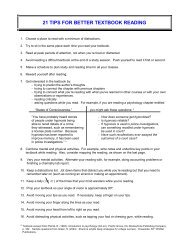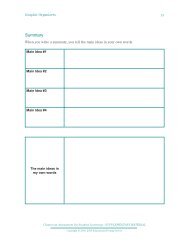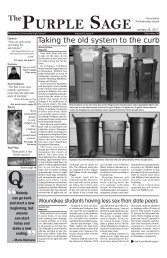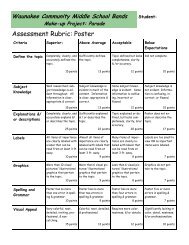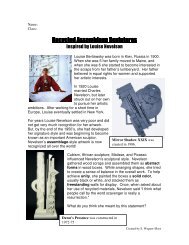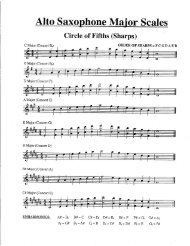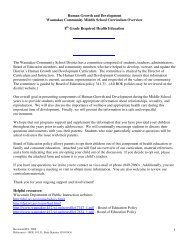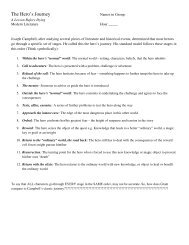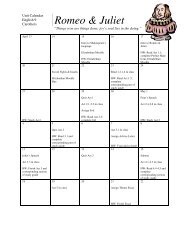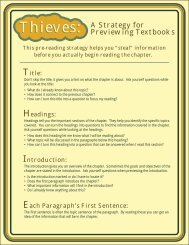Figure Sculptures
Figure Sculptures
Figure Sculptures
- No tags were found...
You also want an ePaper? Increase the reach of your titles
YUMPU automatically turns print PDFs into web optimized ePapers that Google loves.
Name:Hour:<strong>Figure</strong> <strong>Sculptures</strong>The human figure has been a favorite subject of artists throughout time. Prehistoricartists painted hunters on cave walls creating some of the earliest known images ofhumans. Since that time artists have drawn, painted, carved, and sculpted human figuresusing a wide variety of media. Think about figurative artwork (figurative artworkdepicts the human body) that you have seen. What materials did the artist(s) use?For this project we will be studying the human figure. We will create a series of gesturedrawings, discuss proper proportions of the human body, and create a final sculpture ofa figure in action.GESTURE DRAWINGGesture drawings are quick sketches that capture the basic poseof a figure. Even though gesture drawings are made quickly, theyare based on careful observation. Here are some tips for creatingeffective gesture drawings:• Look carefully at the figure. Where is the activity ortension? (Examples: folded arms, outstretched limbs,twisted torso, weight on one foot, etc.)• Do not worry about outlining the figure. Stick figures areOK!• Work on the entire drawing; don’t get caught up in onearea.• When you have the basic lines recorded on your paper,draw basic shapes you’ve observed.• Don’t get frustrated if your drawings seem rough or disjointed, gesture drawingsbecome easier with practice!!Created by Sophie Wagner-Marx
FIGURE PROPORTIONSIn general, the human body is 7 or 8“heads” tall. Here are someguidelines for establishing idealproportions in the human figure.• Shoulders are 2 head lengths(not widths) wide• Chin to chest is one headlength• Chest to belly button is onehead• Belly button to where legsmeet body is one head length• Legs are 3-4 head lengths• Arms are 3 heads to finger tips 1. You will be using a variety of materials to create a figure sculpture in an actionpose. You must create 6 thumbnail sketches before beginning the constructionof your sculpture. Fold a large piece of manila paper into 6 sections andbrainstorm ideas for your sculpture. What are good action poses?2. After completing your thumbnail sketches, choose the sketch you think is themost interesting and effective. On a separate piece of paper, lay out theproportions for your sculpture. You must show this to the teacher before you willreceive the armature wire for your sculpture.3. An armature is the skeleton of a sculpture. (Your armatureshould NOT include all of the bones in the body. A basicstick figure is sufficient.) An armature gives the forms ofsculpture strength. Using your fingers and/or wire tools,create the stick figure that will become your finishedsculpture. Remember to use proper proportions!! Arethere any accessories you can add using cardboard?4. Attach your armature to a wooden base.5. Build up your figure; give it depth. Fold, crumble, tape, etc.newspaper to give your figure thickness. Cover yoursculpture with one or two layers of papier-mâché. LET ITDRY COMPLETELY.6. Use acrylic paint to decorate your sculpture and base.Created by Sophie Wagner-Marx



